The automotive industry manufactures some parts that can only functions when joined to other parts during the assembling process. As a result, automotive part manufacturing relies on designs with high tolerance and incorporates joining mechanism features, of which fasteners are very common.
Fasteners are critical in the automotive part manufacturing industry as they aid in the assembling and functioning of automotive parts. There are different types of automotive fasteners based on materials, make-up and intended functions. This article will discuss the different fasteners, their functions, and their possible applications.
Automotive Fasteners By Materials
The most common way of classifying automotive fasteners used in automobiles is by using the make-up material. Generally, there are two categories, metals, and plastics, each with different attributes and functions based on the material properties.
Metal Automotive Fasteners
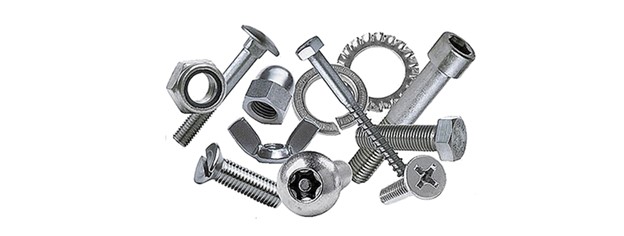
Generally, metal automotive fasteners come from iron, aluminum alloy, and copper. Depending on the chosen materials, they can exhibit different levels of mechanical properties, such as strength, durability, and corrosion resistance.
Metal automotive fasteners come in different forms, including bolts, nuts, springs, and screws. They are durable, reusable, and applicable in connecting and securing heavy automotive, suspension, and engine parts.
Metal automotive fasteners are also subjectable to the surface finishing process for better functionality and aesthetic appeal. Common examples applicable in automotive part manufacturing include galvanization and anodizing to improve rust protection and durability.
Plastic Automotive Fasteners
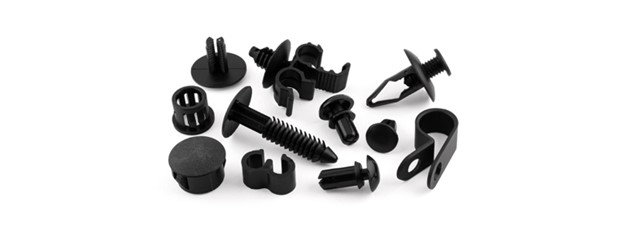
Plastic automotive fasteners are a better option when looking for optimum mechanical properties with more elaborate aesthetics. They are a popular option for making fasteners, including pins, spacers, connectors, and washers, alongside other composite materials such as rubber.
Plastic fasteners come majorly from vinyl known for their tensile strength and brittleness. As a result, they are applicable in making fasteners for replaceable or one-time use. Furthermore, they cost less than metal fasteners and do not conduct electricity or rust.
11 Common Types of Automotive Fasteners
Aside from classification by materials, another classification of automotive fasteners is by their functions. Below are the common types you need to know:
Nuts
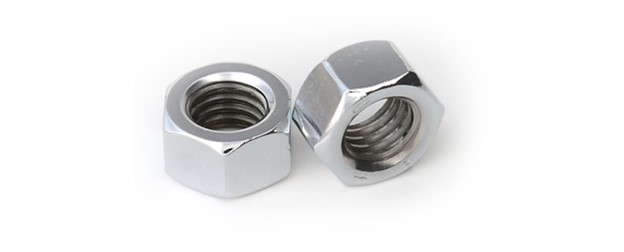
A nut is a small metal component made using iron or aluminum alloys. It has a spiral cut threading made using 3D printing running through its center and fits over the bolts along both sides. Alongside the washers, the nut and bolts help in fastening automotive parts. Although there are several types of nut fasteners, the most common is the hex nut, characterized by a hexagonal outer shape. Other types of nut fasteners used in the automotive industry include:
- Cap nuts are only accessible from one side. The other side has a smooth domed surface to prevent injury.
- Barrel nuts are cylindrical and insertable into a hole running perpendicular to the bolt axis.
- Flange nuts have hexagonal heads with an increased diameter around the base. As a result, they do not need a washer.
- Knurled nuts have a large textured diameter, as a result, you can tighten them by hand.
Bolts
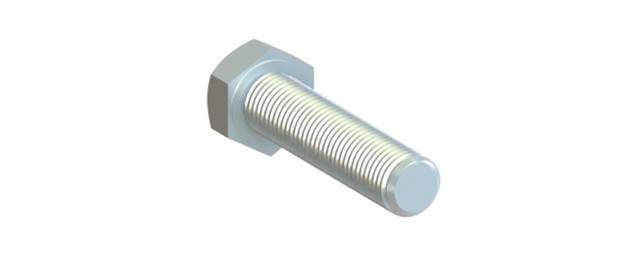
A bolt is a fastener with a long partially-threaded shaft with a non-tapered end. The unthreaded part is called the shank and provides precision and less abrasion. Furthermore, the shank can extend beyond the parts interface depending on the face placed on the bolt.
Bolts are made using metals such as iron and aluminum alloys and are a simple but irreplaceable option. Like the nut, the most common is the hex bolt with a hexagonal head. Together with a nut or a washer, it is applicable in holding automotive parts such as engine components, dashboards, and suspension arms. Different types of automotive bolts include:
- Hex flange bolts feature a washer under the hex head. This helps in force distribution and securing the parts.
- Carriage bolts feature a dome and an enlarged head.
- Place bolts feature self-locking and free-spinning hexagonal heads that prevent loosening because of vibration.
Screws

Screw is a fastener with a completely tapered shaft that holds two parts together. It can cut its thread in a hole (self-tapping screws) or mate with a threaded hole in a part (machine screws). Unlike the bolt, it does not require a washer or nut, as the threading secures and holds it in place.
Like automotive nuts and bolts, the most common screw is the hex screw. It is similar to the hex bolt, although it lacks a shank. Other types of screw fasteners used in the automotive industry include:
- Countersunk head screw: A machine screw with a tapered head that lies flat with the surface of a part.
- Cap head screws are automotive screws with a barrel-shaped head and fitting socket.
- Pan head screw: A machine screw that has a domed head fitted with a socket.
- Wood screws.
- Self-tapping screws.
- Coach screw: A large self-tapping screw with a hex head that allows high torque when fitting.
Fasteners Used for Automotive Design
There are several types of fasteners used in automobiles. Each comes with a different level of performance and reliability. Below are the common fasteners used for automotive design.
– Self-Clinching Fasteners
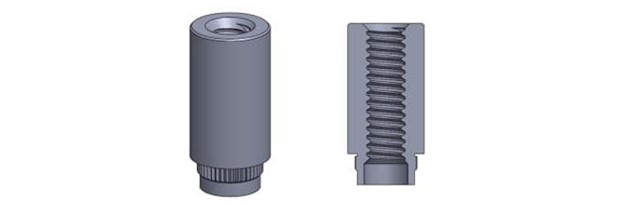
Self-clinching fasteners are one-time and permanent fasteners applicable in joining automotive sheet parts. They have a serrated clinching ring that prevents rotation and comes in different styles and functions, including pins, nuts, studs, blinds, and standoff fasteners.
– Riveting Fasteners
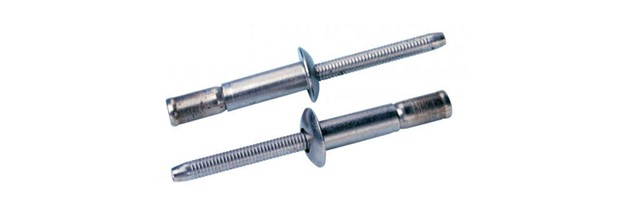
A rivet is a fastener with a head and tail at opposite ends. It comes mainly from steel or aluminum and helps achieve permanent part assembly. There are several types of rivets, including solid rivets, blind rivets, tubular rivets, and split rivets, applicable in joining two or more automotive parts.
– Blind Threaded Inserts
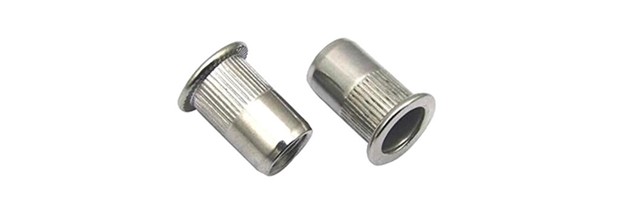
Blind threaded inserts have blind threading that allows them to be installed on one side of the panel. These inserts are suitable for joining tubing, extrusions, etc.
Studs

Studs are fasteners with external threading that looks like a screw without a head (some have heads). They are generally permanent fasteners, most often welded into the parts you want to join. Furthermore, you can thread studs at both ends, making them pairable with nuts.
A common type of stud applicable in the automotive is the wheel stud used in holding the wheels of automobiles.
Washers
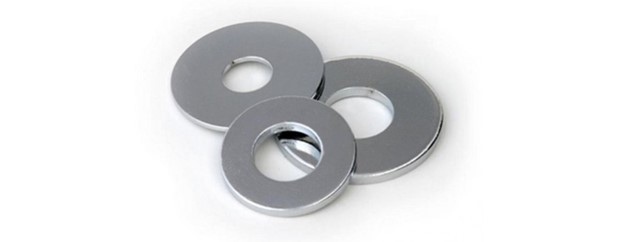
A washer is a disk with a thin flat surface and a hole in the middle. When used together with a nut and bolt, it helps distribute the bolt’s load/pressure and keeps the nut from loosening. It comes in different shapes and styles that function depending on the automotive components you want to join.
In automotive parts assembling, washers are applicable in an axle bearing, or a joint to prevent loosening, relieve friction, prevent leakage, or distribute pressure.
Clips

Clips are important fasteners made from plastics or metals with automotive and non-automotive functions. They have several designs but offer more straightforward solutions. In automotive part manufacturing, they are applicable in positioning or holding different parts, including interior panels, door cards, or plastic bumpers (plastic). Clips can be reusable or non-reusable.
Clamps
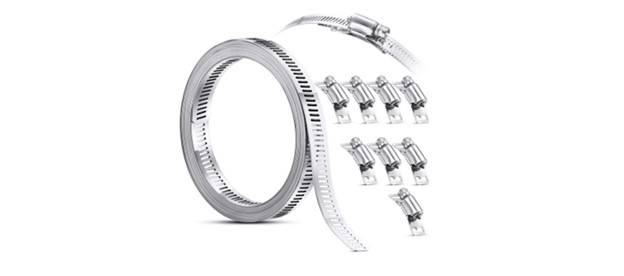
Clamps are common automotive fasteners applicable to holding components such as hoses and tubes attached to the engines. They are generally metallic, although a few can be plastics. They have a classic design and a screw applicable in tightening the fastener, which in turn tightens the components.
Springs
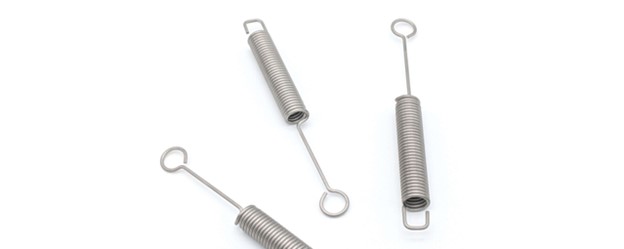
Springs are metallic fasteners such as spring clips, pins, and washers that exhibit elastic deformation. As a result, they function in creating tension between two automotive components.
Their exhibition of elastic deformation ensures a secure connection while allowing easy assembly and disassembly of parts. An example of spring fastener application in the automotive industry is using R clips to prevent the wheel from coming off the end of the shaft.
Pins

Pin fasteners can keep automotive components in place but allow some movement. They can be plastic and metals and come in different types.
In the automotive industry, common types include the cotter pin that prevents axial movement of a shaft hence their use in wheels. Another example is the lynchpin used in off-road cars and the clevis pin used in the vehicle braking system.
Specialty Fasteners
These types of automotive fasteners have a special design that makes them applicable to certain industries, materials, and applications. In automotive part manufacturing, they are applicable when the part manufacturer needs a special design due to their uniqueness in shape, material composition, or application. Before using a specialty fastener, there is a need for testing to ensure that it performs well.
– Surface Mount Fasteners
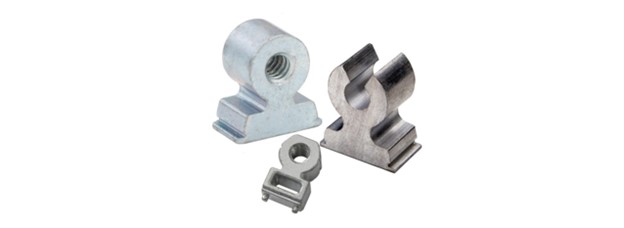
These fasteners use the surface mount technology that involves adhering the fastener directly onto the solder pad on the printed circuit board surface. The surface mount technology removes damage to automotive parts during installation, improves assembly speed, and reduces scrap/waste.
– Broaching Fasteners

Broaching fasteners are available in stud, nut, standoff, etc., pressed and attached to non-ductile materials or ductile materials with a maximum hardness of aluminum. They have a simple installation and are applicable when the surface mounting is unsuitable.
– SI® Fasteners
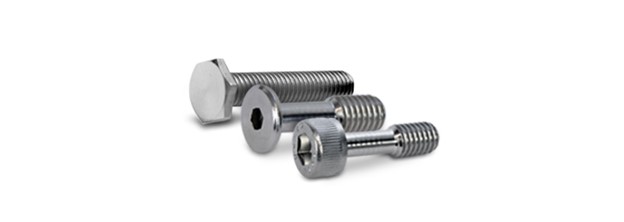
SI® inserts are special fasteners applicable in joining plastic parts which require strong and permanent threading. Furthermore, they are applicable when the unit requires frequent assembly and disassembly.
The Importance of Proper Tightening of Automotive Fasteners
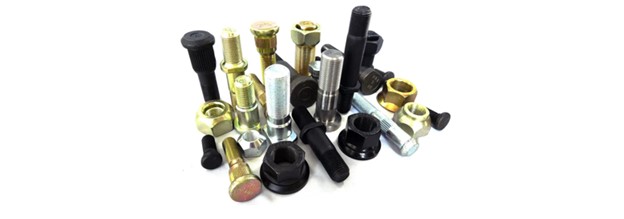
Choosing the right types of automotive fasteners is very important. However, aside from choosing, proper tightening of the fastener is critical in its function.
There are several instances where tightening becomes important. For example, improper tightening in the engine can cause bolts to loosen, preventing the car from starting. In addition, improper tightening of fasteners in the brakes of vehicles can increase the chance of accidents.
Due to the risk associated, choosing the right fastener is critical as the wrong pair of fasteners can severely impact the vehicle’s performance or lead to damage to the parts.
Need Fasteners for Automotive Test Products?
Choosing the right types of automotive fasteners is a critical process. As a result, automotive part manufacturers need a reliable automotive fastener manufacturer. At RapidDirect, we can help you make different types of automotive and aerospace fasteners for prototyping or end-use products based on your requirements.
Our engineering team is highly experienced in different automotive fasteners manufacturing processes, like CNC machining, Sheet metal fabrication, and 3D printing, and can answer your question or provides design suggestions for your design. We can make both plastic and metallic types of automotive fasteners of very high quality and high precision that guarantees the proper function of a vehicle. Upload your design today and get instant quotes and free DfM analysis.
Bonus: How to Eliminate Risks to Loosen Automotive Fasteners
Due to the vehicle/part performance risk or the tendency for accidents to occur, it is important to ensure that fasteners are well-tightened. Below are several ways to eliminate the risks of loose automotive fasteners.
Choose Robust Material
The choice of material plays a huge role in the properties and application of the automotive fastener. As a result, you should ensure you choose a sturdy material with the needed properties to hold the two automotive parts together effectively.
For example, automotive fasteners made from iron, aluminum, and other metals are strong and durable. However, plastic automotive fasteners such as vinyl have less durability but are more replaceable.
Doing Some Assessment Beforehand
Assessing the purpose of the fastener would allow you to reduce labor and repair costs. You should ensure that the material properties match the application of the fastener. For example, it would be a waste of capital to use metal automotive fasteners in replaceable parts.
Test the Torque
The torque denotes the rotational force applied to a fastener which helps you tighten the fastener. It is important to test the torque to reduce the chance of loosening.
– Torque-tension testing
This involves using the machines such as a Skidmore-Wilhelm Bolt Tension Calibrator to measure the required torque to achieve a specified tension.
– Bearing surface testing
Bearing surface testing will determine how the surface area and roughness affect friction.
– Coefficient of Friction
This test will measure the kinetic and static resistance of a surface dragged across another.
Conclusion
Fasteners are a crucial component in joining two automotive parts together. Hence, they aid in the functioning and assembling of automotive parts. Fasteners have several types and designs based on their make-up materials and functions. This article discussed the different types of fasteners used in the automotive part manufacturing industry, their functions, and their possible applications. Do you have a question about manufacturing automotive fasteners? Kindly contact us.
FAQs
The three main types of threaded fasteners are bolts, screws, and studs. The hex head bolts are the most common fastener used in the automotive industry.
An automobile has about 3,500 fasteners.
The strongest material for manufacturing fasteners such as screws and bolts is titanium. Due to its durability, it is mainly used in heavy-duty applications such as the aerospace and medical industries.


